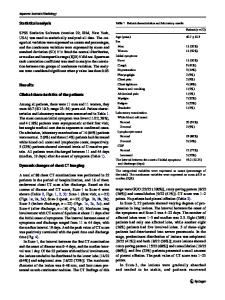Dynamic Chest Image Analysis: Model-Based Perfusion Analysis in Dynamic Pulmonary Imaging
- PDF / 1,344,437 Bytes
- 12 Pages / 600 x 792 pts Page_size
- 102 Downloads / 262 Views
Dynamic Chest Image Analysis: Model-Based Perfusion Analysis in Dynamic Pulmonary Imaging Jianming Liang Turku Centre for Computer Science, DataCity, Lemmink¨aisenkatu 14 A, 20520 Turku, Finland Email: [email protected]
¨ Timo Jarvi Turku Centre for Computer Science, DataCity, Lemmink¨aisenkatu 14 A, 20520 Turku, Finland Email: [email protected]
Aaro Kiuru Department of Diagnostic Radiology, Turku University, 20520 Turku, Finland Email: [email protected]
Martti Kormano Department of Diagnostic Radiology, Turku University, 20520 Turku, Finland Email: [email protected]
¨ Erkki Svedstrom Department of Diagnostic Radiology, Turku University, 20520 Turku, Finland Email: [email protected] Received 31 January 2002 and in revised form 25 October 2002 The “Dynamic Chest Image Analysis” project aims to develop model-based computer analysis and visualization methods for showing focal and general abnormalities of lung ventilation and perfusion based on a sequence of digital chest fluoroscopy frames collected with the dynamic pulmonary imaging technique. We have proposed and evaluated a multiresolutional method with an explicit ventilation model for ventilation analysis. This paper presents a new model-based method for pulmonary perfusion analysis. According to perfusion properties, we first devise a novel mathematical function to form a perfusion model. A simple yet accurate approach is further introduced to extract cardiac systolic and diastolic phases from the heart, so that this cardiac information may be utilized to accelerate the perfusion analysis and improve its sensitivity in detecting pulmonary perfusion abnormalities. This makes perfusion analysis not only fast but also robust in computation; consequently, perfusion analysis becomes computationally feasible without using contrast media. Our clinical case studies with 52 patients show that this technique is effective for pulmonary embolism even without using contrast media, demonstrating consistent correlations with computed tomography (CT) and nuclear medicine (NM) studies. This fluoroscopical examination takes only about 2 seconds for perfusion study with only low radiation dose to patient, involving no preparation, no radioactive isotopes, and no contrast media. Keywords and phrases: chest images, dynamic chest image analysis, pulmonary perfusion, perfusion model, effects of contrast media.
1.
INTRODUCTION
The lungs take air in order to absorb oxygen from air into blood. This means that sufficient pulmonary ventilation (air flow) and perfusion (blood flow) are essential for the lungs to function properly; inadequate lung function may be due to failure in ventilation or perfusion among other factors. In
order to detect abnormalities in lung ventilation and perfusion, ventilation isotope scan and perfusion isotope scan are conventionally used. They can provide a static, coarse geographic 2D distribution of air/blood in the lungs, but they have the disadvantage of using radioactive isotopes. Chest X-ray is the primary imaging method for the diagnosis of pulmo
Data Loading...











